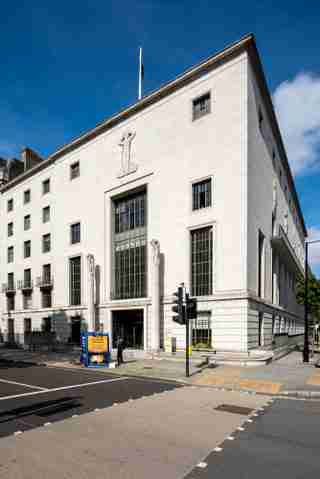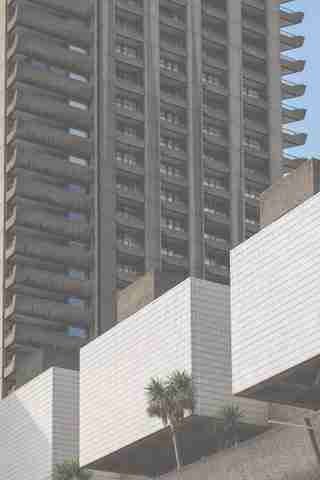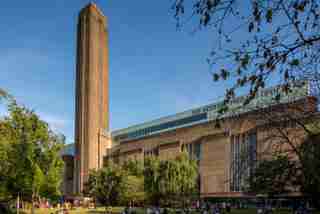Assembling an architectural “best of” list is a daunting task, especially when your choices include 100 years of buildings. So when putting together his new book Best Buildings Britain (ACC Art Books, $25), author Matthew Freedman decided to take a different approach. Rather than making the list himself, he asked 31 notable architects and writers to give their picks.
“While the book doesn't try to be definitive or exhaustive, it offers readers a chance to look again at modern British architecture through the eyes of all sorts of experts,” says Freedman. “These choices come from architects at various stages of their careers, but also from writers who have played key roles in defining Art Deco style, raising a defense of Brutalism, championing the postmodern era, and so on. The resulting cocktail places postwar ‘prefabs’ alongside large-scale 1970s public housing projects, and Deco department stores near 1980s pumping stations.”
Architects such as Norman Foster, Richard Rogers, and Ivan Harbour weighed in alongside experts in the field to create the list of 75 buildings built since 1918. “I hope the mix of working architects and thoughtful commentators expands the idea of what might constitute a ‘best building’ in interesting ways,” Freedman says. “It's fascinating to see Norman Foster choose an AIROH prefabricated bungalow as a formative influence in his work, for example, while Jonathan Meades includes Owen Luder's now demolished Brutalist Tricorn shopping center in Portsmouth.”
Once the contributors’ lists were in, Freedman started with buildings that were picked more than once. He then expanded the list to 75 to make sure there was a wide range of styles and geographical areas. While there are plenty of iconic buildings in the book, the list has quite a few unexpected structures: “I think that the element of surprise choices is a big part of the book's appeal—especially when you turn to the back, look at each contributor's individual list, and see dozens more buildings to spark your curiosity.” Read on to see 15 of Britain’s best buildings.

RIBA Headquarters
The London home of the Royal Institute of British Architects was designed by architect George Grey Wornum and completed in 1934. The Art Deco building, which was nominated by architect Owen Luder, a past president of RIBA, is filled with decorative details, including ceiling panels depicting architecture’s high points located in the first floor’s Henry Florence Memorial Hall.

Barbican Complex
Completed in 1982, Chamberlin, Powell and Bon’s Barbican Complex is one of Britain’s best-maintained Brutalist developments. Built on land devastated by World War II bombing, the complex includes more than 2,000 homes. The estate was on the lists of architects Richard Hywel Evans, Jenny Fleming, and Piers Gough; and writers Stefi Orazi and Anne Ward.

Tate Modern
Swiss architecture firm Herzog & de Meuron transformed Giles Gilbert Scott’s Bankside Power Station into the Tate’s gallery of modern art. The firm adapted the industrial space into a new landmark with impactful spaces such as the Turbine Hall. Architects Peter Clegg, Nigel Coates, and Owen Luder all listed the Bankside building as one of their picks.
The Shard
Designed by Renzo Piano Building Workshop, the Shard has helped define the London skyline since it was completed in 2012. The 72-floor skyscraper is the tallest building in the city and combines office space, a hotel, restaurants, and residences. It was a pick of architect Richard Rogers, who designed Paris’s Centre Georges Pompidou with Piano; journalist Bevis Hillier also nominated the distinctive tower.
Lloyd’s Building
Architect Richard Rogers designed the striking headquarters for insurance market Lloyd’s of London, which was completed in 1986. Rogers moved all of the building’s internal components, such as pipes, elevators, staircases, and bathrooms, to the exterior, creating open and flexible interiors. The building was the most frequently chosen by the book’s contributors, appearing on 10 lists.
London Aquatics Center
Designed by Zaha Hadid for the 2012 Olympic Games, the London Aquatics Center is topped with a wavy aluminum roof and features an undulating timber ceiling inside the main diving and swimming event pool space. Richard Rogers included Hadid’s contribution to Queen Elizabeth Olympic Park on his list.
Engineering Building, University of Leicester
James Stirling and James Gowan’s design for the Engineering Building at the University of Leicester was nominated nine times for the book. The 1963 building is clad in brick, a nod to the area’s Victorian industry, and the workshops and laboratories are topped with a striking glass roof.
Penguin Pool
Three structures from the London Zoo made the list, including the Penguin Pool, designed by Berthold Lubetkin and the Tecton Group. Completed in 1934, the structure features a pool topped with two cantilevered ramps, as well as steps and nesting boxes around the edge.
A House for Essex
Artist Grayson Perry and FAT Architecture collaborated on A House for Essex, a building-artwork on the banks of the River Stour. The home celebrates the life of Julie Cope, a character created by Perry, and the exterior is covered in custom tiles showing symbolic details from her life. Journalist Bevis Perry and writer Anne Ward each nominated the immersive structure.
1, 2, & 3 Willow Road
The terrace of three houses on Willow Road in Hampsted, London, was one of Hungarian architect Ernő Goldfinger’s first major projects in Britain. The modern homes, completed in 1939, were clad in brick instead of the white stucco that was common in the era. It’s rumored that James Bond creator and Hampstead resident Ian Fleming hated the buildings so much that he borrowed the architect’s last name for one of his most famous villains. The homes were nominated by architect Keith Bradley.
Preston Bus Station
Architects Keith Ingham and Charlie Wilson of Building Design Partnership (BDP) designed the Preston Bus Station in Lancashire. The building contains a spacious waiting area topped with four stories of parking, which are accentuated with swooping concrete elements. Architectural historian Elain Harwood and writer Anne Ward both included the station on their lists.
The Lawns
Architects Andy MacMillan and Isi Metzstein of Gillespie, Kidd & Coia designed the Lawns, a residence hall at the University of Hull in East Yorkshire. The brick complex contains a social center and six halls made up of tightly connected three-story blocks. The Lawns were picked for the book by architects Birkin Haward and Jonathan Sergison.
Apollo Pavilion
Abstract artist and architect Victor Pasmore designed Apollo Pavilion, a 1969 structure in Peterlee, County Durham. The reinforced concrete bridge is made up of rectangular forms, and straddles an artificial lake on the Sunny Blunts Estate. Nominated by architects Claire Harper and James Perry and writer Stefi Orazi, the Apollo Pavilion was restored by Burns Architects and given a Grade II listing in 2011.
The Sugden House
Alison and Peter Smithson’s Sugden House, completed in 1956 in Hertfordshire, was one of the architects’ early commissions and one of the few private homes they designed. The home blends traditional elements of suburban housing with playful design details, such as the irregularly placed windows and mix of interior materials. Four experts, including writer John Grindrod and architects Birkin Hayward, Charles Holland, and Jonathan Sergison, included the house on their lists.
St. Bride’s Roman Catholic Church
Gillespie, Kidd & Coia completed St. Bride’s Roman Catholic Church in East Kilbride, Glasgow, in 1964. The interior of the monolithic brick structure is illuminated by a glazed roof and copper-clad dormers. The contemporary church was refurbished in 2016 and was nominated by architects Claire Harper, James Perry, and Simon Henley, and writer Anne Ward.
